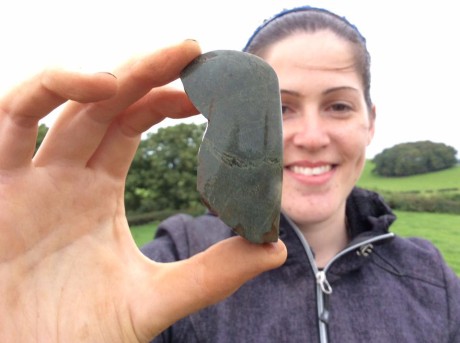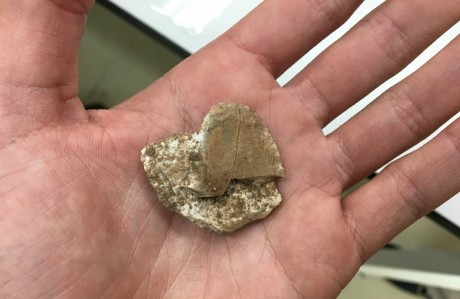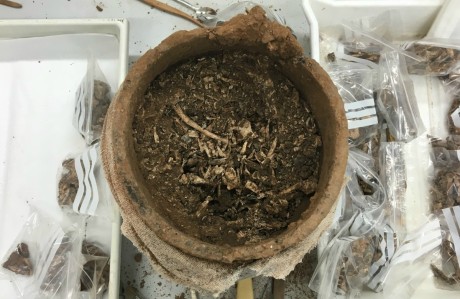
The people of the Bronze Age may be famous for constructing huge monuments and burying spectacular hordes, but in northern Britain they also buried their dead along with ceramic containers known to archaeologists as ‘food vessels’. But how useful is that term, and what did these often beautifully decorated vessels really mean? Neil Wilkins, the British Museum’s Bronze Age Curator, has some of the answers.
In July 2016, I was lucky enough to be in Lancashire when DigVentures discovered a curious ceramic vessel near Morecambe Bay; curious because it had been buried upside down, and sealed in place with three large stones.
First we excavated the base, then the body, and finally the neck. As more and more of it emerged, it was clear that someone had decorated it by pressing something – possibly the tip of their thumb – into the clay over and over again, to create several rows of imprints running around the neck of the pot.
Judging by its shape, its distinctive decoration, the fact that it was buried upside down, and by the thick, coarse clay it was made from, this vessel was something pretty special; a distinctive type of pottery placed with the dead mostly in northern Britain and in Ireland during an early part of the Bronze Age (2,200 – 1,800 BC), and which archaeologists have until recently generally referred to as ‘Food Vessels’.
But were they really food vessels? Early archaeologists first coined this term in order distinguish them from the drinking cups we now call Beakers. To them, the rim of these ‘food vessels’ seemed too thick to serve as a good drinking vessel and, they deduced, they were more likely to have been made for holding food.
Today, the name is as unhelpful as it is unimaginative, as it disguises what is actually a pretty remarkable pottery tradition. It gives the impression that they were primarily functional or domestic vessels, when really most of them have been recovered from rather special contexts, usually graves. The moniker really doesn’t do justice to just how interesting and special these ceramics can be.

Firstly, there are different sizes of these so-called ‘Food Vessels’. The smaller ones, which are usually less than 30cm tall, are often found in graves with unburnt bodies (inhumations), while the larger ones tend to contain cremated remains, and are never found placed with unburnt bodies. Strict rules applied!
Secondly, the timing of when these vessels start to appear in Bronze Age burials is interesting. Beaker pots (as found near Stonehenge in the grave of the famous Amesbury Archer) were brought over to the British Isles by people from the European continent, along with new beliefs and technologies, including metalworking.
When Food Vessels appear in the archaeological record a few hundred years later, they are the first vessels to be found placed with the dead after Beaker pots. These ‘Food Vessels’ seem to be the first British and Irish replies to those new concepts and practices, and presumably also their associated beliefs about the afterlife.
While Food Vessels do seem to reference these earlier Beakers, they are also a new departure. In the face of new technologies and beliefs, we can just imagine people asking: what’s next, what do we believe the dead need, or what can we give them now? It’s fascinating to see how they took something successful, changed it and made it their own. It’s even more fascinating to ponder whether they were even aware of that change taking place, or whether it happened slowly and without anyone realising it.
Their regional distribution is interesting too. Broadly speaking, they’re only found ‘up North’, and this northern distribution may be a reflection of a regional identity – not all parts of Britain had the same connections and networks of trade and exchange at this time.
One factor is the closeness of Northern Britain (especially Western Scotland) to Ireland, where Food Vessels were also popular and may have first been made. Other networks – such as trade in bronze and beautiful black jet jewellery from Whitby in Yorkshire – may also have played a part in the spread of objects and ideas. Some of the vessels that have been found are extremely similar, despite coming from graves many tens or hundreds of kilometres apart, suggesting long-distance networks of trade and exchange long before the introduction of roads or high speed communications.
In terms of their cultural or cosmological significance then, they may reflect a regional identity – a sense of being from a particular area. But identity then wasn’t necessarily inward looking, because it clearly extended across the Irish Sea and often referenced other traditions from Europe and the past.
With all that said, these Food Vessels may very well have been used in everyday life to store and serve food; something that could be investigated with analysis of any remains stuck to the pot’s inner surface. If that’s the case, they may also reflect a belief that the dead needed sustenance and provision for the journey to the afterlife or for the afterlife itself.
How people lived during this early part of the Bronze Age is still quite an enigma. Very few houses are known (probably because people were still quite mobile and had quite low population densities) and the little we do know about people is mostly through their cemeteries and burials.
That’s why these vessels are so important, and this one particularly so because not that many have been found in the area, despite it clearly being well positioned for connections along the Irish Sea and into Yorkshire.
Whether or not they were used for storing food during life, these ‘Food Vessels’ were important enough to be placed with the dead by their mourners. And they were important for a really momentous part of the Bronze Age, when people were first dealing with the implications of the new technology of metalworking, its trade and exchange.
These vessels give us a window into that world, and have been underappreciated for too long. I hope this new discovery, and its continued analysis over the coming months, helps to further our knowledge about their significance, in Lancashire and in the rest of northern Britain.


